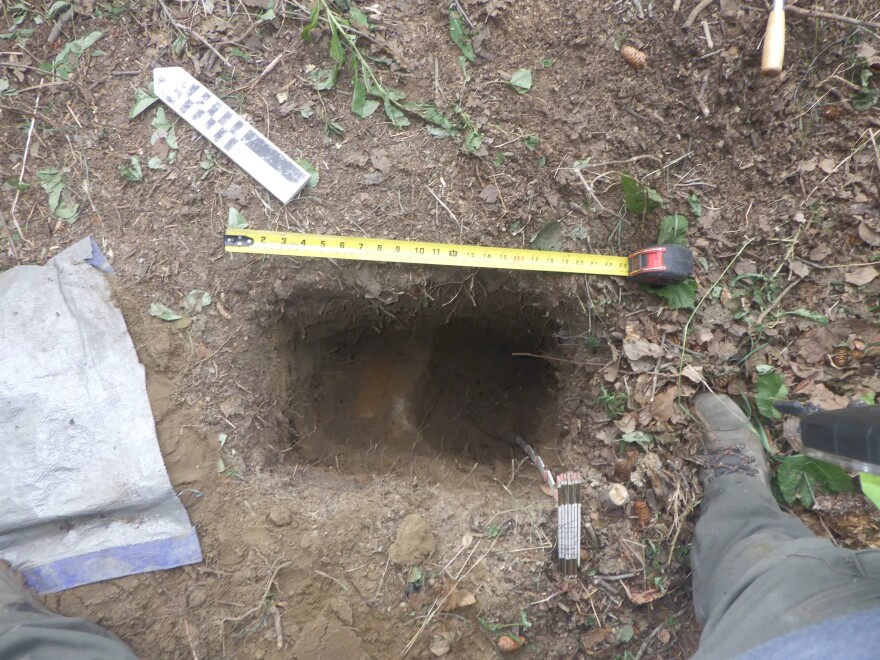Archeologists found a cache near Cook Inlet this summer that dates back almost a thousand years. The discovery is another testament that the Dene people have been the stewards of the lands in Southcentral Alaska for at least a millennia, tribal officials said.
“It's further confirmation of Denaʼina oral tradition,” said Aaron Leggett, the president of the Native Village of Eklutna. “It also shows that there's still a lot more work to be done on Denaʼina archeology, and especially in Upper Cook Inlet.”

The cache – which is essentially a root cellar – was likely used for storing food. It was discovered in June at an existing archeological site at Joint Base Elmendorf-Richardson, military officials announced in a December press release.
The site has been associated with Dene, or Athabaskan, culture. In Alaska, the Dene include Dena’ina and Ahtna people, as well as other cultural groups of the Interior and Southcentral regions. Leggett said that the Denaʼina people often followed the coast through the corridor of what is now JBER to get to fish camps in Anchorage.
Archeologists expected the cache to be a couple hundred years old, but radiocarbon dating of the soil samples proved otherwise, said Liz Ortiz, an archaeologist and cultural resources program manager with JBER.
“When we got the results back that said it was 960 years, plus or minus 30, we were shocked,” Ortiz said. “(We) were jumping up and down in our cube in tears. It was very, very exciting.”
While some archeological sites in Alaska date up to 14,000 years back, development and less stable ground conditions in Southcentral often facilitate degradation, said another JBER archeologist and cultural resources program manager, Margan Grover.
“In the scale of Alaska archeology and history, it's not very old, right? But there's no sites that are that old on this side of the Inlet,” she said about the discovery. “It's just like a little time capsule up there.”

The site is tucked away at a scenic spot, perfect to watch for belugas, Grover said.
“You're at the top of the hill, and there's giant spruce trees and birch trees and Knik Arm is just right there in front of you,” she said.
The cache – which is about three-and-a-half feet deep – was lined with birch bark to keep dirt, moisture and rodents out, Grover said. Because the location is so close to the water, researchers expected to see traces of marine animals and fish inside the cellar, but the soil samples showed terrestrial animals such as moose or caribou, Ortiz said.


Later this year, archeologists plan to revisit the site and evaluate the soil around the pit to learn if those initial samples showed what kinds of meat were stored inside the cache, or if they just reflect which mammals lived in the area.
To get more context about the place, the researchers collaborated with elders and knowledge holders from Denaʼina and Ahtna tribes. This is how they learned about one physical landmark at the site – an old birch tree that has a letter T carved into it.
Eklutna elders remember a fish camp in the area that belonged to the Theodore family with ties to Eklutna and Knik tribes, and some of them believe that the carving was an identifier for the camp, Grover said.

Such discoveries are important to discuss to highlight the long-standing Indigenous history of Anchorage’s urban landscape, Grover said.
“Anchorage is a new town. You know, 1914 is when it's first established,” she said. “But there are people who were here much longer than that, and they were amazing stewards of this land, and so we have to make sure we acknowledge that.”
Oral history and archeological analysis often go hand in hand, said Angela Wade, who is a Chickaloon village tribal citizen and its tribal historic preservation officer.
“There are things that we know inherently from what was passed down about living in a place, but there are other things that these archeological sites tell us about the past … and about hardship,” Wade said. “And how our people really persevered through things like volcanic winter or time when the fish didn't show up.”
Today, half of Alaska’s population lives within the Dene lands, and a lot of those areas have been disturbed. Still, tribal leaders said that a careful analysis of the remaining sites – in consultation with the tribes – is crucial.
“I feel like every site that we learn about, every site that we can further investigate, is a piece of our history that was potentially lost,” Wade said. “So this is kind of regaining some of the history that we were separated from.”


